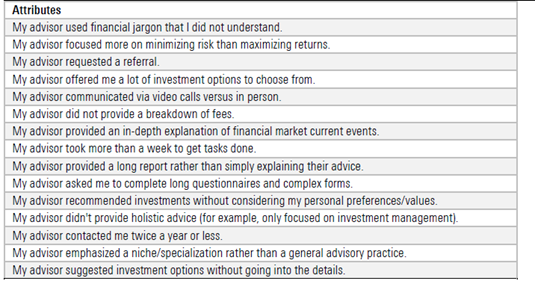7 Faux Pas for Financial Advisors To Avoid
When it comes to managing a relationship with your client, little mistakes can have big consequences.

Time and again, research shows the personal relationship between a client and their advisor is paramount to both parties’ success. Without a strong personal relationship, advisors cannot provide the customized, high-quality level of advice that clients are looking for nowadays. Because of this, clients may disengage with their advisor or outright fire them if they experience a lack of personal relationship along with lackluster advice.
In our latest research, we investigated which advisor behaviors contribute to investor disengagement. Moreover, we dove into how investor disengagement presents itself in the advisor-client relationship.
Death by a Thousand Cuts
We started our research by collecting common advisor behaviors. We then asked advisor clients to rate how frequently they experienced each behavior. For those they reported experiencing, we asked participants to rate their emotional response to the behavior (on a scale from “I really disliked it” to “I really liked it,” with a neutral midpoint). We then asked participants how each behavior affected their relationship with their advisor across four dimensions: their trust in their advisor, their decision to collaborate with their advisor, their decision to allocate assets for management, and their decision to recommend their advisor to others.
Common Advisor Behaviors

Which Common Advisor Behaviors Do Clients Dislike Most?
We found seven actions that clients reported disliking (in order from most to least disliked):
- Did not provide a breakdown of fees.
- Took more than a week for tasks.
- Used financial jargon.
- Recommended investments without considering values.
- Suggested investment options without going into details.
- Asked me to complete long forms.
- Did not provide holistic advice.
For the rest of the actions in the survey, clients reported either neutral or positive feelings (see paper for full results). To understand the impact of these disliked behaviors, we created a composite score of the four dimensions and then identified the relationship between the score and each disliked behavior. We found that how much a client disliked an action had a moderate, negative impact on their relationship with their advisor. In other words, an investor experiencing a disliked behavior was discouraged from trusting and recommending the advisor, as well as encouraged to invest less with and to stop working with the advisor.
Faux Pas No More: Being Conscious of Disliked Behaviors
Some of the advisor behaviors we investigated in our research may seem harmless on the surface but can lead to disastrous wounds over time. It’s all too easy to wave off these results, with the claim that you (as a financial advisor) don’t do these things to your clients. Other advisors use financial jargon that leave clients confused or speed past investment explanations. Not you, of course. Unfortunately, we find more than half of the clients experienced each of these behaviors with their own advisors—making these behaviors a lot more common than any advisor should be comfortable with.
To help advisors make sure they aren’t one of the culprits, we created a two-step takeaway that’s accessible in the full white paper. The first step is a checklist that advisors can use before and during a conversation with a client, so they can reflect and address the top five disliked behaviors we found in our research. Step two is a follow-up survey template that advisors can send to clients after a meeting. The survey subtlety asks the client if they experienced any of the top five disliked behaviors during their meeting with their advisor. Compared with being face-to-face, the online format of the survey may encourage honest feedback; instead of being put on the spot, clients have time to reflect on the meeting and provide comprehensive feedback.
Together, this two-step takeaway can help advisors ensure they are not accidentally tearing down the relationships they meant to develop.
The author or authors do not own shares in any securities mentioned in this article. Find out about Morningstar’s editorial policies.

/s3.amazonaws.com/arc-authors/morningstar/e03cab4a-e7c3-42c6-b111-b1fc0cafc84d.jpg)
/cloudfront-us-east-1.images.arcpublishing.com/morningstar/2TT3THVKOJAKBFGHCCRTVPNEQ4.png)
/cloudfront-us-east-1.images.arcpublishing.com/morningstar/6NPXWNF2RNA7ZGPY5VF7JT4YC4.png)
/cloudfront-us-east-1.images.arcpublishing.com/morningstar/RYIQ2SKRKNCENPDOV5MK5TH5NY.jpg)
:quality(80)/s3.amazonaws.com/arc-authors/morningstar/e03cab4a-e7c3-42c6-b111-b1fc0cafc84d.jpg)